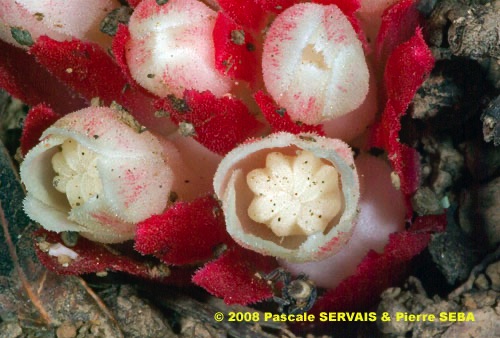
Cytinus hypocistis subsp. clusii Nyman
Fam. : Rafflesiaceae
© Pascale SERVAIS & Pierre SEBA, 2018. Tilo Botanica: Flore de Tilos et du Dodécanèse / Flora of Tilos and of the Dodecanese
English translation by Brenda Bradbury, Howard Bradbury and Stéphane Léonard
Plante herbacée, monoïque, dépourvue de chlorophylle, parasite des Cistus creticus.
Feuilles alternes, réduites à des écailles oblongues, rougeâtres, charnues, se recouvrant les unes les autres en enveloppant complètement la tige, à bords irrégulièrement dentés.
Fleurs à symétrie radiaire, blanchâtres ou crème, de 10 à 12 mm de diamètre, réunies par 5 à 10 en bouquets charnus d’abord recouverts d’écailles à pointe d’un rouge éclatant. Calice à 4 sépales pétaloïdes dentés sur les bords. Fleurs mâles à 8 étamines formant une colonnette centrale et situées au-dessus des fleurs femelles qui ont 1 style.
Fruits, baies charnues.
___________________________
Plant herbaceous, monoecious, without chlorophyl, parasite of the Cistus creticus.
Leaves alternate, reduced to oblong, reddish scales, fleshy, overlapping and wrapping the stem completely, with irregularly toothed edges.
Flowers radially symmetrical, whitish or cream, from 10 to 12 mm in diameter, joined together by 5 to 10 in fleshy clusters initially covered in pointed scales of a bright red. Calyx with 4 petaloid sepals toothed on edges. Male flowers with 8 stamens forming a central small column and located above the female flowers which have 1 style.
Fruits, fleshy berries.
Descripteurs / Identifying features
1
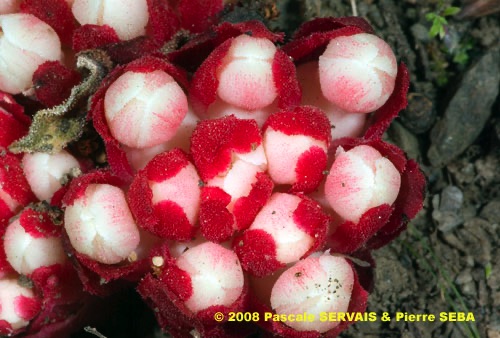
2
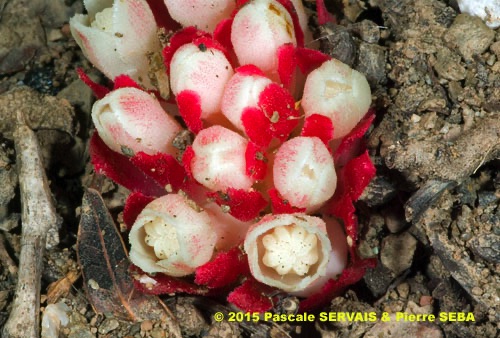
3
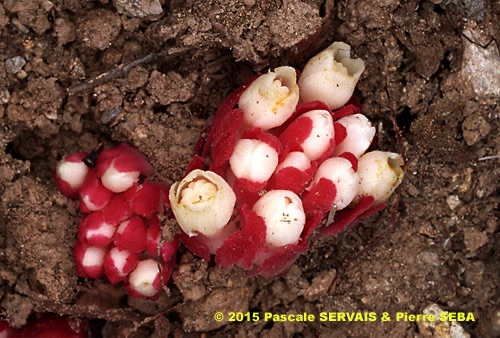
4
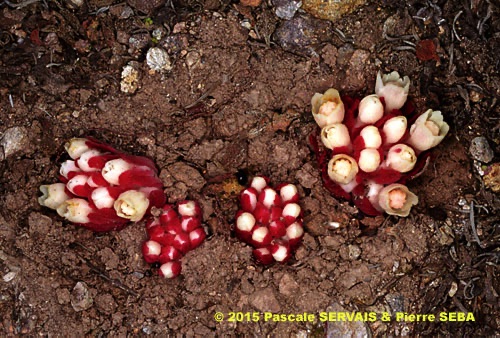
5
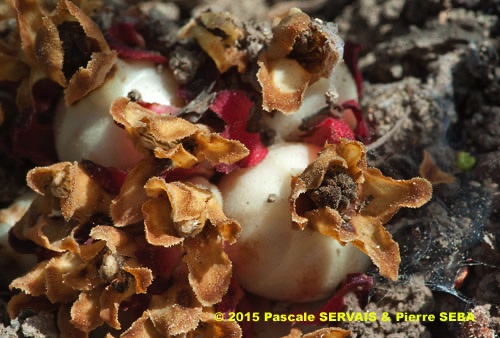
6
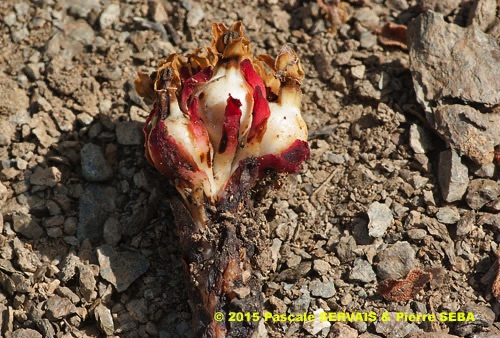
7
Étymologie / Etymology :
Cytinus : emprunt du latin cytinus, -i (nom) = le calice de la fleur du
grenadier, forme latinisée du grec ancien κύτινος, -ου (nom)
= la fleur du grenadier, en référence à sa ressemblance avec la
fleur de grenadier.
Hypocistis : emprunt du grec ancien ὑποκιστίς, -ίδος (nom)
[ < ὑπό (prép.) = sous + κίστος, -ου (nom) = le ciste ] = qui pousse
sous les cistes qui sont l’hôte unique de cette plante parasite.
Clusii : nom donné en l’honneur de Carolus Clusius (1526-1609),
médecin et botaniste flamand de langue française, créateur à Leyde
de l'un des premiers jardins botaniques d'Europe.
Cytinus : borrowed from Latin cytinus, -i (noun) = calyx of the flower of
pomegranate, Latinized form of the Classical Greek κύτινος, -ου
(noun) = flower of pomegranate, referring to its resemblance to the
flower of pomegranate.
Hypocistis : borrowed from Classical Greek ὑποκιστίς, -ίδος (noun)
[ < ὑπό (prep.) = under + κίστος, -ου (noun) = cistus ] = which grows
under the cistus which are the only host of this parasitic plant.
Clusii : name given in honour of Carolus Clusius (1526-1609), Flemish
doctor and botanist of French language, creator in Leiden of one of
the first botanical gardens in Europe.
Synonymes / Synonyms :
Cytinus ruber Fritsch
Cytinus clusii (Nyman) Gand.
Cytinus hypocistis subsp. kermesinus (Guss.) Arcang.
Cytinus hypocistis var. kermesinus Guss.
Hypocistis rubra Fourr.
Noms vernaculaires / Common names :
Noms français / French names :
Cytinet de L’Écluse — Cytinet rouge.
Noms grecs / Greek names :
Κίτισος — Κίτισος υποκύστις — Κύτινος ο υπόκιστος —
Λύκος της λαδανιάς.
Nom anglais / English name :
Red cytinus.
Nom allemand / German name :
Roter Zistrosenwürger.
Nom espagnol / Spanish name :
Hipocístide rojo.
Noms italiens / Italian names :
Ipocisto rosso — Ipocisto rosso di Clusius.
Habitat :
Lieux pierreux - Lieux incultes.
Stony places - Waste ground.
Îles / Islands :
Patmos - Tilos.
Hauteur / Height range :
De 2 cm à 10 cm.
From 2 cm to 10 cm.
Floraison / Flowering time :
De mars à juin.
From March to June.
Groupe / Classification :
Dicotylédones.
Dicotyledons.
Pérennité / Lifespan :
Vivace.
Perennial.
Description :
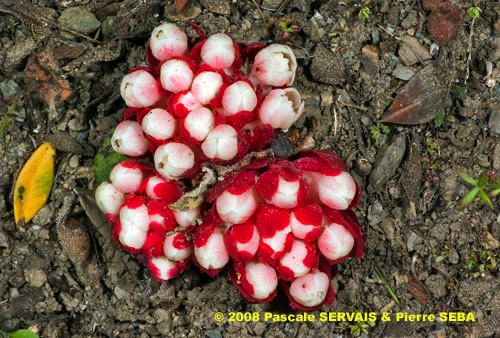
8
Clés dichotomiques et descripteurs distinctifs des 2 espèces / Dichotomous keys and distinctive identifying features of the 2 species
Photo 1 :
Localisation / Location : Tilos, Megalochorio, Plaka
Date : 16/04/2008
GPS : Lat. 36,46227° N / Long. 27,30738° E / Alt. 50 m
Type : Photographie numérique / Digital Photograph (10 mégapixels)
Photo 2 :
Localisation / Location : Tilos, Megalochorio, Plaka
Date : 16/04/2008
GPS : Lat. 36,46227° N / Long. 27,30738° E / Alt. 50 m
Type : Photographie numérique / Digital Photograph (10 mégapixels)
Photo 3 :
Localisation / Location : Tilos, Megalochorio, Plaka
Date : 16/04/2008
GPS : Lat. 36,46227° N / Long. 27,30738° E / Alt. 50 m
Type : Photographie numérique / Digital Photograph (10 mégapixels)
Photo 4 :
Localisation / Location : Patmos, Kambos, Livadi Kalogiron
Date : 28/04/2005
GPS : Lat. 37,37070° N / Long. 26,56250° E / Alt. 4 m
Type : Kodak Gold 200 ASA
Photo 5 :
Localisation / Location : Patmos, Kambos, Livadi Kalogiron
Date : 28/04/2005
GPS : Lat. 37,37070° N / Long. 26,56250° E / Alt. 4 m
Type : Kodak Gold 200 ASA
Photo 6 :
Localisation / Location : Tilos, Megalochorio, Plaka
Date : 23/05/2015
GPS : Lat. 36,46377° N / Long. 27,30571° E / Alt. 45 m
Type : Photographie numérique / Digital Photograph (10 mégapixels)
Photo 7 :
Localisation / Location : Tilos, Megalochorio, Plaka
Date : 23/05/2015
GPS : Lat. 36,46377° N / Long. 27,30571° E / Alt. 45 m
Type : Photographie numérique / Digital Photograph (10 mégapixels)
Photo 8 :
Localisation / Location : Tilos, Megalochorio, Plaka
Date : 16/04/2008
GPS : Lat. 36,46227° N / Long. 27,30738° E / Alt. 50 m
Type : Photographie numérique / Digital Photograph (10 mégapixels)

Google Maps
Google Maps
Google Maps
Google Maps
Google Maps
Google Maps
Google Maps
Google Maps